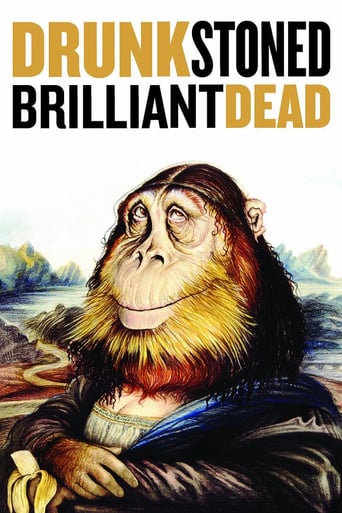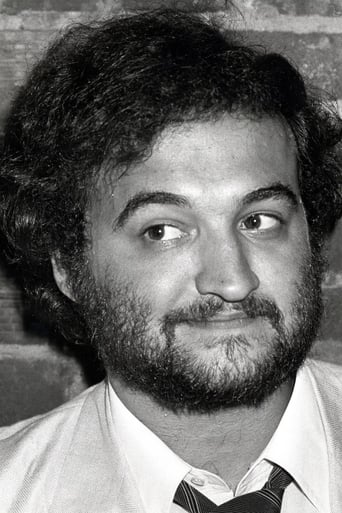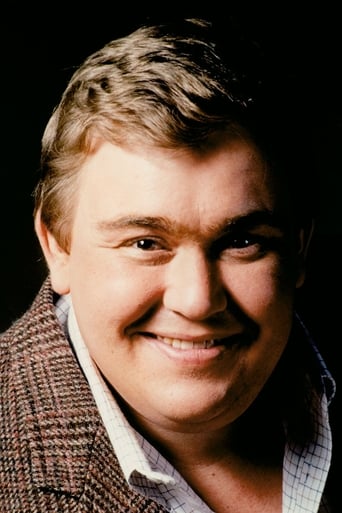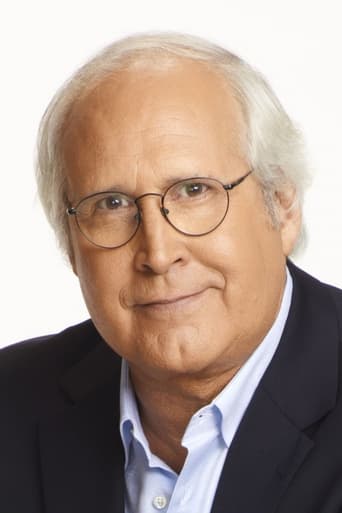Drunk Stoned Brilliant Dead: The Story of the National Lampoon (2015)
A look at the history of the American comedy publication and production company, National Lampoon, from its beginning in the 1970s to 2010, featuring rare and never before seen footage, this is the mind boggling story of The National Lampoon from its subversive and electrifying beginnings, to rebirth as an unlikely Hollywood heavyweight, and beyond. A humour empire like no other, the impact of the magazines irreverent, often shocking, sensibility was nothing short of seismic: this is an institution whose (drunk stoned brilliant) alumni left their fingerprints all over popular culture. Both insanely great and breathtakingly innovative, The National Lampoon created the foundation of modern comic sensibility by setting the bar in comedy impossibly high.
Watch Trailer
Cast


Reviews
Good start, but then it gets ruined
To all those who have watched it: I hope you enjoyed it as much as I do.
It's a movie as timely as it is provocative and amazingly, for much of its running time, it is weirdly funny.
By the time the dramatic fireworks start popping off, each one feels earned.
DRUNK STONED BRILLIANT DEAD: The Story of the National Lampoon (2015)*** 1/2 (out of 4)If you're a fan of the National Lampoon's magazine then you're certainly going to want to check this documentary out. The rise and fall of the magazine is discussed in this highly entertaining documentary that features interviews with surviving members of the magazine as well as those who got their start in the movies like NATIONAL LAMPOON'S ANIMAL HOUSE, CADDYSHACK and NATIONAL LAMPOON'S VACATION.There's some really good material to have here but the documentary works the best for those who are unfamiliar with the magazine or just don't know the complete history behind it. We get some great stories about the early days as well as how the magazine finally took off, which of course led to Hollywood calling. There's some discussion of Saturday Night Live who stole a lot of their talent as well as some of the darker stories including the death of one of the founding members.There are some great stories throughout this and there are some great interviews as well. I must say that the interview with Chevy Chase was probably my favorite because we really see a different side of him including a rather painful side as he talks about losing his best friend.
It's notable that none of the truly successful / funny people who got their start via Lampoon- related ventures (Bill Murray, Harold Ramis, etc.) are in this movie, vouching for the quality of the Lampoon. Why is this? Because they owe their start to Second City, not to the Lampoon. Just as the Lampoon blames Lorne Michaels for taking "their" talent wholesale, they took this talent from Second City - people like John Belushi, Gilda Radner etc. ever wrote for or even had anything to do with the Lampoon. Animal House had a few laughs and, as noted in the movie, created a genre, but a realistic viewer will suspect the laughs are the result of (non-Lampoon) Harold Ramis. Caddyshack was crap. P. J. O'Rourke is (still) a pompous, unfunny drunk / conservative. Chevy Chase is here, promoting the Lampoon because the Lampoon is affiliated with his glory years 3 decades ago. The National Lampoon may have been considered shocking, new, or different, but it simply wasn't as funny as this movie makes it out to be. A truly timeless work will stand on its own. What is the legacy of the Lampoon? Quite a few people spell it out in this movie: "tits". Pictures of breasts and juvenile cartoons. Breasts are great, but (generally) not funny. If the Lampoon had classic, funny articles, people would still be referencing them (people still reference the Marx Brothers or Shakespeare). But they don't - why do you think that is?
For many of us our first introduction to off kilter and subversive humor came in the form of a magazine that was on newsstands everywhere. For pre-teens it was less the humor that was involved that got our attention but the fact there was nudity in it and it wasn't hidden under the counter. But for those who loved a good laugh it was the premier source of humor to find at the time, our own generations humor as opposed to that of what was popular at the time. There is a huge difference between Henny Youngman cracking wise about his wife and a magazine cover that pictured a dog with a gun to its head that read "Buy this magazine or we'll shoot this dog".This movie takes a look at NATIONAL LAMPOON from its inception to its demise, covering all bases good and bad. A spin off of the HARVARD LAMPOON, the magazine was started by Doug Kenney, Henry Beard and Robert Hoffman. It was a humor filled magazine that parodied and focused on what was happening in the country, sort of like MAD magazine but from a more adult perspective. What the three of them did was bring in many of the most thought provoking comedy writers of the time to work for the magazine and in return its success skyrocketed.You have to remember that these were the days before comedy clubs dotted the country and skit based comedy took over the airwaves. As a matter of fact it was from National Lampoon that many of those who went on to take over the airwaves began. As the magazine grew in popularity things happened that altered what was to come. Kenney left for a time leaving the magazine in the hands of Beard alone. A workaholic who helped create the tone of every issue, his disappearance had an effect on all involved.But what helped move the downfall of the magazine as well was the departure of many of the staff members. As the magazine grew it evolved into a number of albums, weekly radio shows and stage productions involving those writers. NATIONAL LAMPOON'S LEMMINGS was a record and stage show featuring both John Belushi and Chevy Chase. As those writers and performers left for shows like Saturday NIGHT LIVE, the magazine suffered. Many other noted writers stepped in and did well but they too left.The magazine got involved in movies in 1978 with the release of NATIONAL LAMPOON'S ANIMAL HOUSE but by then the magazine sales were dwindling. More successful movies followed but the magazine had lost its punch, relegating itself to special issues, rehashes of old issues and more nudity rather than humor. Eventually it ended publication.This documentary takes a look at all of that. Using a stills, filmed footage and numerous interviews with those involved it blends them together to take us through the magazine as it was and as it ended. It talks about the good and the bad, never whitewashing facts to suit those who loved it non-stop. In so doing it also reflects the evolution of comedy from that time period. Nearly every major comedy writer or humorist at the time had some connection to the magazine be it SNL writer Michael O'Donoghue, political satirist P.J. O'Rourke or screenwriter John Hughes.In some ways it was the success of the magazine that led to its demise years later. Coupled with a generation that relies solely on visual media and ignores printed matter there was little hope that the magazine could go on. Watching this movie makes that a sad realization that so much was lost when the magazine folded. But with this film many who weren't aware of the contribution to comedy that came from the magazine will be realized. Perhaps enough so that people will go back in search of old issues, maybe one fan will be inspired to create his own LAMPOON someday. We can hope.Until then we can watch and learn from some of the most creative comic minds of the past century on screen here. It serves as a reminder that creativity and humor can walk hand in hand and inspire one another. And it lets others know that there was something funny long before they were born, something this generation seems to not realize yet. With this movie the proof is there. An interesting and delightful documentary that captures the time and the laughs in only 98 far too short minutes.
Director Douglas Tirola boasts (somewhat cheekily) that Drunk Stoned Brilliant Dead features more bare breasts than any other documentary in history. Judging by the raucous end result that details the hard- partying genesis and spectacular flameout of the National Lampoon humour magazine, he may well be right.From an inauspicious start at Harvard to an ignominious end (that is mostly glossed over), National Lampoon magazine proved notable and memorable, with Drunk Stoned Brilliant Dead reliving all the glory years of drugs, clubs, pubs, parties, and oh yeah, ground-breaking humour too. Focusing on the many disparate players that had a hand in the magazine (including numerous publishers, comedians, actors, hangers-on, and most importantly, the core writers that drove it all) Tirola wrangles a cacophony of voices and personalities into a digestible narrative that zips along with wit and verve.It helps that his subjects are a motley crew of top-rate satirists, a group who at one time helped make National Lampoon the 2nd most popular magazine in the country and a world-changing counter- cultural force. Yet with the inevitable rise comes a crashing fall, exemplified by broken friendships, drug casualties, untimely deaths, and other assorted tragedies. It's an epic story and a must-watch for comedy nerds and casual fans alike.Founders Doug Kenney and Henry Beard are the main subjects, although a litany of faces (many famous) chime in throughout on the impact and legacy of National Lampoon itself. Kenney and Beard are shown to be the initial visionaries who, along with the help of publisher Matty Simmons and a key group of art directors, launched the magazine. National Lampoon spun off a Harvard publication in 1970 and immediately showed an irreverent wit and willingness to go after any target with ruthless precision (the bigger the better). Politics, race, gender, the rich, the famous – they were all fair game and National Lampoon tore them to shreds with razor-sharp satire (like a more ribald precursor to Saturday Night Live, and later The Colbert Report and The John Oliver Show).Behind the scenes it was a non-stop party, with the Lampoon's New York office being a hub of sex. drugs, and rock 'n' roll. The writers had free reign to imbibe and indulge in whatever they liked, so long as a magazine was produced each month. And with coke-fuelled marathon writing sessions and Kenney and Beard's dogged work ethic, they were able to keep up. It was highly dysfunctional but many of the talking head segments reveal former staff members looking back on their time in those madhouse offices fondly.Tirola keeps the tone lively and fast-paced, using excerpts from National Lampoon's radio show and comedy albums as audio-only interstitials, and bringing many articles and illustrations to life through animation combined with vivid recollections from the folks who were on the front lines. Among them are Billy Bob Thornton, Tim Matheson, Kevin Bacon, and other actors who were related to the brand (a fresh-faced Bacon got his ass paddled in a memorable sequence from Animal House), as well as those that were profoundly influenced by the magazine and its spinoffs, like comedy hitmaker Judd Apatow.There's great archival footage of early National Lampoon troupe members like Bill Murray, Gilda Radner, John Belushi and Harold Ramis performing, which sadly recalls that three of those four have passed away now (while the ever-elusive Murray appears only in old footage). Chevy Chase figures prominently into the narrative, as he was one of the first members of the comedy troupe and was a close friend to co-founder Doug Kenney. The making of Caddyshack (not an official Lampoon production but featuring many alumni) is recounted in detail, as is the uproar over and eventual exaltation of the classic Animal House, which helped make the careers of John Landis and Ivan Reitman (both of him appear on-camera as well).For every interview that Tirola may have missed out on (an extremely young Christopher Guest is seen fleetingly in footage from the 70's), there's three great anecdotes that will have audiences either in stitches over some ridiculous tale, or watching raptly as the next drug trip goes bad or close friend is lost. There's a wealth of material to draw on, and to the movie's credit it remains fleet and sure-footed, nimbly picking which story to expand and which interviewee to probe.Chase himself – once a titan of comedy but now often seen as an ungrateful blowhard – is humanized greatly and his relationship with the hard-living Kenney provides an emotional anchor for the craziness surrounding the Lampoon. The loss of life and shattered friendships are not glossed over but the film does make the needed decision to focus mostly on the main players of the Lampoon as there's only so much screen time.The later years of the magazine become somewhat dire as much of its best writers and actors are poached by Hollywood and Lorne Michaels, but the film (and the magazine) soldier on in the face of adversity. The down slide is given less screen time and Matty Simmon's hand- waving away of the bad later years is both glib and appreciated in the context of the movie (when asked about Michaels, Simmons responds "Who?" with a smile). While the magazine ended in 1998, its brand and looming influence continues to live on.The film is necessarily guided by who would speak with Tirola but in the end that turns out to be a surprisingly large number of notable individuals, recognizable entertainers, and even more names who may not be as familiar but whose contributions were great and deservedly remembered here. If a documentary's job is to be true to its subject while informing and entertaining, then Drunk Stoned Brilliant Dead achieves that goal with ease. To paraphrase the Lampoon's most famous magazine cover, "Watch this movie or we'll shoot this dog."









